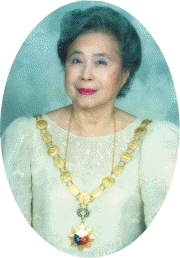 Born : July 24, 1917, Jolo, Sulu
Born : July 24, 1917, Jolo, Sulu
She is the second child
of pioneer physicians Sixto Orosa and Sevedna Luna, and the elder sister
of critic Rosalinda Orosa. She is married to Benjamin Goquingco. They have
three children, two of whom-Rachelle and Regina-are both dancers. Orosa-Goquingco
graduated valedictorian of her high school class, and finished bachelor of
science in education, summa cum laude, at St. Scholastica's College. She
took graduate courses in theater craft, drama, and music at Columbia
University and Teachers College in New York City, USA.
Her early ballet training was under Lilia Lopez, Epifania Rodriguez, and Luva Adameit. She took professional and teacher's courses at the Ballet Russe de Monte Carlo, coming under the tutelage of Ifilda Butsova, Thalia Mara, Anatole Vilzak, and Madame Ludmilla. National Artist in Dance Francisca Reyes-Aquino was also once her mentor.
In 1934, at the age of 17, she started her major dance experiments and, in 1939, was the only dancer on the First Cultural Mission to Japan. That same year, she produced Circling the Globe, and a year later, Dance Panorama. In 1940 she created The Elements, the first ballet choreographed by a Filipino to commissioned music, and Sports, featuring cheerleaders, a tennis match, and a basketball game. A year later, she choreographed the first Philippine folkloric ballet, Trend: Return to the Native.
 After
World War II, she organized the Philippine Ballet where she brought to
life Maria Clara, the leper, Sisa, Elias, and Salome-all characters in
Rizal 's novel Noli Me Tangere (Touch Me Not). In 1958 she founded
the Filipinesca Dance Company.
After
World War II, she organized the Philippine Ballet where she brought to
life Maria Clara, the leper, Sisa, Elias, and Salome-all characters in
Rizal 's novel Noli Me Tangere (Touch Me Not). In 1958 she founded
the Filipinesca Dance Company.
Orosa-Goquingco was inclined not only to classical ballet but also to Indian and Spanish, as well as modern, dance. She is noted for her courage in breaking traditions in dance despite public indifference. Her other important works include Vinta!, Morolandia (choreographed in 1938), Festival in Maguindanao (depicting a Muslim royal wedding), Eons Ago: The Creation (depicting Philippine legends of the creation of the world and of the first man and woman), Filipinescas: Philippine Life, Legend, and Lore in Dance, and Miner's Song. Inevitably her innovations revolutionized the folk dances. The Bird and the Planters is the first weaving together of the various rice-planting sequences, climaxed by a new version of the tinikling where the dancer personifies the tikling bird. It was the first to utilize bamboo poles to catch the bird, the first to use a double-time finale and breathtakingly rapid turns while the dancer hops in and out of the bamboo poles. Orosa-Goquingco's Tribal, about the death of a warrior, is the first dance composition in the Mountain Province-dance style. Other works along the same line are "Ang Antipos" (The Flagellant), " Salubong ", (Meeting), "Pabasa" (Reading of the Pasyon)--all dance sequences celebrating Philippine lenten practices. Philippine games such as palo sebo, sipa, and juego de anillo were depicted in Easter Sunday Fiesta. Orosa-Goquingco is also remembered for her transmutation into dance theater of the cockfight, the asalto, and the fiestas.
Additionally, under her own name and pen name (Cristina Luna), she has been published by the Philippine Cultural Foundation and Philippine periodicals, by Arts of Asia (Hong Kong), Enciclopedia dello Spettacolo (Rome, Italy), and Grove's Dictionary of Music and Musicians. She is the author of a history of Philippine dance, Dances of the Emerald Isles 1980, and of the popular one-act play, Her Son, Jose Rizal.
Orosa-Goquingco has
received numerous awards, among them the Patnubay ng Sining at Kalinangan
Award, 1961; the Rizal Centennial Award, 1962; Patnubay ng Sining at
Kalinangan award and Republic Cultural Heritage Award, 1964; Presidential
Award of Merit, 1970; Tandang Sora Award, 1975; and the Columbia
University Alumni Association Award, 1975.
She
was proclaimed National Artist in Dance on 27 March 1976.
. M. Enriquez